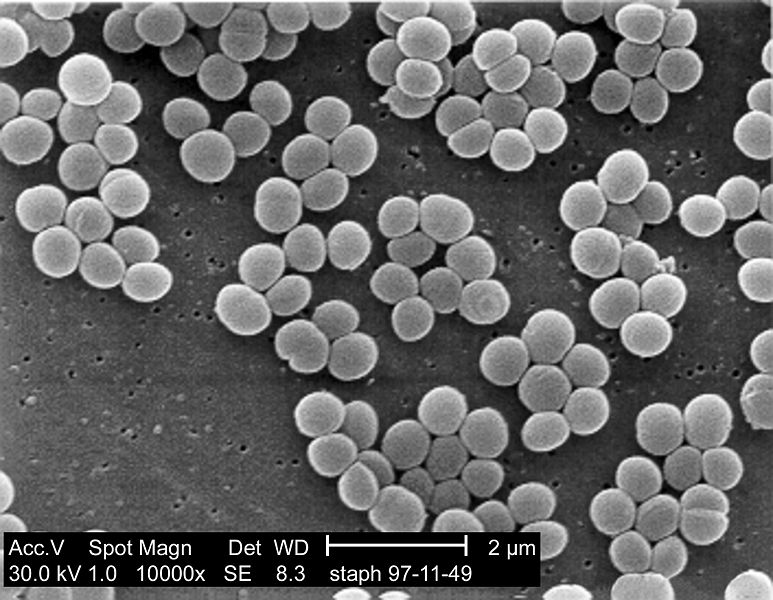Staphylococcus: Difference between revisions
m (Robot: Automated text replacement (-{{SIB}} +, -{{EH}} +, -{{EJ}} +, -{{Editor Help}} +, -{{Editor Join}} +)) |
m (Robot: Automated text replacement (-{{reflist}} +{{reflist|2}}, -<references /> +{{reflist|2}}, -{{WikiDoc Cardiology Network Infobox}} +)) |
||
| Line 70: | Line 70: | ||
==References== | ==References== | ||
<div class="references-small"> | <div class="references-small"> | ||
{{reflist|2}} | |||
</div> | </div> | ||
{{clr}} | {{clr}} | ||
Revision as of 15:05, 6 September 2012
| Staphylococcus | ||||||||||||
|---|---|---|---|---|---|---|---|---|---|---|---|---|
 SEM micrograph of S. aureus colonies; note the grape-like clustering common to Staphylococcus species.
| ||||||||||||
| Scientific classification | ||||||||||||
| ||||||||||||
| Species | ||||||||||||
|
S. afermentans |
Editor-In-Chief: C. Michael Gibson, M.S., M.D. [1]
Overview
Staphylococcus (in Greek staphyle means bunch of grapes and coccos means granule) is a genus of Gram-positive bacteria. Under the microscope they appear round (cocci), and form in grape-like clusters.[1]
The Staphylococcus genus includes thirty-one species.[2] Most are completely harmless, and reside normally on the skin and mucous membranes of humans and other organisms. Found worldwide, they are a small component of soil microbial flora.[3]
Role in disease
Staphylococci can cause a wide variety of diseases in humans and other animals either through toxin production or invasion. Staphylococcal toxins are a common cause of food poisoning as it can grow in improperly stored food. Although the cooking process kills them, the enterotoxins are heat resistant and can survive boiling for several minutes. Staphylococci can grow in foods with relatively low water activity (such as cheese and salami).
- One pathogenic species is Staphylococcus aureus, which can infect wounds. These bacteria can survive on dry surfaces, increasing the chance of transmission. Methicillin-resistant Staphylococcus aureus (MRSA) has recently become a major cause of hospital-acquired infections and is being recognized with increasing frequency in community acquired infections. S. aureus is also implicated in toxic shock syndrome; during the 1980s some tampons allowed the rapid growth of S. aureus, which released toxins that were absorbed into the bloodstream. Any S. aureus infection can cause the staphylococcal scalded skin syndrome, a cutaneous reaction to exotoxin absorbed into the bloodstream. It can also cause a type of septicaemia called pyaemia.
- The coagulase positive Staphylococcus that inhabits and sometimes infects the skin of domestic dogs and cats is Staphylococcus intermedius. This organism, too, can carry the genetic material that imparts multiple bacterial resistance. It is rarely implicated in infections in humans, as a zoonosis.
- S. epidermidis, a coagulase-negative staphylococcus species, is a commensal of the skin, but can cause severe infections in immune suppressed patients and those with central venous catheters.
- S. saprophyticus, another coagulase-negative species that is part of the normal vaginal flora, is predominantly implicated in genitourinary tract infections in sexually active young women.
- In recent years several other Staphylococcus species have been implicated in human infections, notably S. lugdunensis, S. schleiferi, and S. caprae.
Staphylococci can also be found on the tips of the fingers. Most commonly it is found on the index finger as well as the thumb. This infection is known as a felon. As are many other Staphylococcus infections, felon is very painful and can be treated with antibiotics. Most S. aureus are penicillin resistant, but vancomycin and nafcillin are known to be effective against most strains.
Biochemical Indentification
Staphylococcus aureus shows beta-hemolysis on Sheep Blood Agar, however S. epidermidis is non-hemolytic on SBA. Both are positive for catalase production.
Cases
In September and October of 2007, 28 students of 4 high schools in Anne Arundel county Maryland contracted the MRSA string of staph. The schools include Old Mill High School, Severna Park High School, Cheasapeake High School, and Glen Burnie High School,also Southern High School(because of the homecoming game vs the gophers).
References
- ↑ Ryan KJ, Ray CG (editors) (2004). Sherris Medical Microbiology (4th ed. ed.). McGraw Hill. ISBN 0838585299.
- ↑ Holt JG (editor) (1994). Bergey's Manual of Determinative Bacteriology (9th ed. ed.). Williams & Wilkins. ISBN 0-683-00603-7.
- ↑ Madigan M, Martinko J (editors). (2005). Brock Biology of Microorganisms (11th ed. ed.). Prentice Hall. ISBN 0131443291.
ca:Estafilococ
cs:Stafylokok
de:Staphylokokken
ko:포도상구균
id:Staphylococcus
it:Stafilococco
he:Staphylococcus
nl:Stafylokokken
sr:Стафилококе
fi:Staphylococcus
sv:Staphylokocker